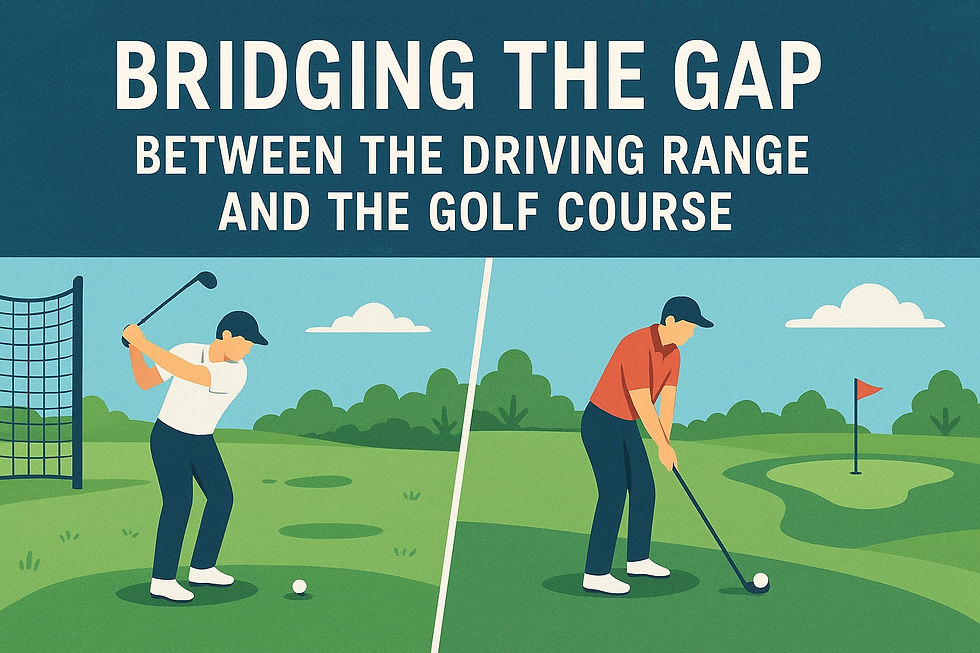The Power of Purposeful Practice: How to Train Like You Play
- Eric J. Mac Donald

- Jul 28
- 3 min read

The Power of Purposeful Practice: How to Train Like You Play
Too often, golfers fall into the trap of hitting bucket after bucket of balls on the range with no real purpose. They get comfortable, hit the same club over and over, and expect that improvement will magically appear on the course. But golf doesn’t work that way—and neither does learning.
The best players in the world know that practice needs to be intentional, variable, and game-like to truly transfer to performance under pressure.
Here’s how you can elevate your game by practicing with purpose:
1. Simulate the Golf Course on the Range
Instead of just hitting balls to a target, simulate holes and real course scenarios. Pick a fairway target and "play" your tee shot. Then grab a club for your approach. Mix in greenside chips and long putts. Give yourself different lies, different clubs, and different outcomes.
This variability teaches your brain to adapt, just like it has to during a round. It keeps you focused and prepares you for the randomness of real golf.
2. Add Pressure and Accountability
Golf is a game of nerves. The best way to prepare is to create pressure in your practice.
Try these ideas:
Set a scoring goal in your short game area (e.g., 10 chips, try to get 7 within 3 feet).
Do a 3-ball putting challenge and restart if you miss.
Have a practice partner or coach keep score.
This type of "consequences practice" increases focus and helps you develop emotional control under stress—exactly what you need on the back nine of a tournament.
3. Track Your Progress with Feedback Tools
Modern tools like TrackMan, SAM PuttLab, and video analysis can provide valuable feedback, but only if you know what to look for. Use data to spot trends and guide improvement. Don't just chase numbers—connect them to your feel and performance.
Keep a training journal and record your practice plans, results, and reflections. This kind of deliberate practice tracking is what separates top performers from the rest.
4. Build a Practice Plan Around Your Scoring Game
Want lower scores? Spend more time on the shots that matter most: wedges, short game, and putting. Your driver might set the tone, but your scoring game seals the deal.
Design a weekly routine that balances:
Full swing technique
Short game variability (bunkers, chips, pitches)
Putting drills and pressure games
On-course practice or simulated play
You don’t need more hours—you need smarter reps.
5. Practice with a Coach Who Holds You Accountable
As a PGA Professional, I guide my students through purposeful, individualized training plans that match their goals, schedule, and skill level. Whether you’re a tournament competitor or weekend warrior, you’ll benefit from structure, feedback, and accountability.
I offer both in-person and remote coaching—so no matter where you are, you can train like you mean it.
Conclusion
Golf improvement doesn’t come from grinding—it comes from smart, focused, and variable training that mirrors how you play.
If you want to:
Break scoring plateaus
Improve under pressure
And make your practice actually matter…
Then it's time to stop hitting and start training with purpose.
🏌️♂️ Ready to Train Smarter?
📍 Located in Boca Raton? Book an in-person lesson.🌐 Prefer online coaching? Start here: www.ericjmacdonaldpga.com📲 Follow me on Instagram for practice ideas, drills, and swing analysis.













.jpg)



Comments